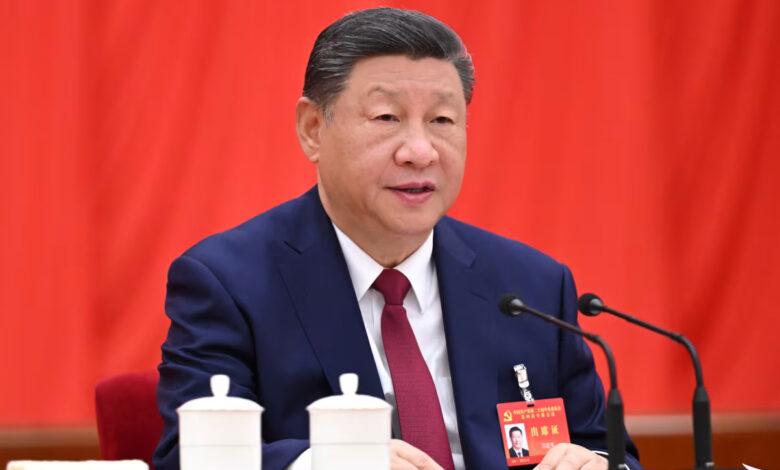
For Chinese leader Xi Jinping, a landmark meeting with Donald Trump expected this week is a moment to showcase something Beijing has long sought: China standing as an equal to the United States on the global stage.
The US president’s trade war against China has challenged Xi’s drive for growth and innovation, but it’s also given Beijing the unintended gift of a bright spotlight under which to flex its economic strength.
As much of the rest of the world scrambled to flatter Trump and negotiate down global tariffs he unleashed this spring, China fought back with its own measures – until both sides were forced to the table for a truce.
In recent weeks, after US rules hit China’s access to American technology and targeted its shipping industry, Beijing fired back by announcing a sweeping expansion of export controls on critical rare earth minerals – a move that rattled Washington and pushed Trump to threaten to pile an additional 100% tariffs on Chinese goods.
Both sides have appeared to climb down from that latest escalation following eleventh-hour trade talks between top negotiators this weekend in Malaysia.
Xi and Trump are now set to meet on the sidelines of an international summit in South Korea Thursday – their first face-to-face meeting of Trump’s second term, where they’re expected to agree to a framework for managing their economic ties.
It’s not yet clear what each side has agreed to concede to get to that point – and this is just one touchstone in a complex and volatile competition between superpowers.
But it will also be a moment where Xi is entering the room after cementing a new reality in US-China relations: China will negotiate, but it won’t be cowed.

‘China is very calm’
All that doesn’t mean that the stakes aren’t high for Xi.
Instead of the US and China working together on global threats as a “G2” of the world’s most powerful economies, Beijing sees a US that aims to hinder its rise with tariffs, high-tech export controls and political friction.
Current US tariffs on Chinese goods – which stand at upwards of 50% on average – are putting pressure on the country’s already slowing economy, and those could more than double if the two leaders can’t find common ground.
But as US officials tout Trump’s ability to “create leverage” to pressure China, over on Beijing’s half of the split-screen, China, too, sees success in its strategy.
There, the common sense is that China is ready for this contest: it’s created natural leverage through its strategic dominance over the global rare earths supply chain; it’s diversified trade to become less dependent on the US market and it’s been pushing to accelerate innovation that would allow it to wean off American goods like high-end semi-conductors.
Beijing was “fully prepared” for how Trump might act toward China when he started his second term, according to Wang Yiwei, director of the Institute of International Affairs at Renmin University in Beijing.
“But from the US side, any tariff or any measures taken (by) the Chinese side has helped President Trump himself to learn the capacity of China is different from eight years ago … and he understands that what is changed – is the US is not the dominant power anymore,” Wang said.
Beijing is also continuing its push to insulate itself from future shocks – including in its upcoming five-year plan, which aims to deepen a top-down drive for tech and industrial self-sufficiency.
“China is very calm in facing all these conflicts and difficulties set up by United States,” Wang Wen, dean of the Chongyang Institute for Financial Studies think tank at Renmin University in Beijing, told a gathering of reporters last week in Beijing.
“The United States is still a major partner, however, among China’s landscape, the US is losing its importance,” Wang added.

Two strongmen
Both sides gave positive signals after trade talks over the weekend, with US Treasury Secretary Scott Bessent suggesting Beijing would defer its controls on rare earths, while the US would pull back its 100% tariff threat and extend an earlier tariff truce.
But China has not made such statements, and there’s still a risk that the two strongmen can’t see eye to eye or a rogue comment throws off the delicate detente. And, as is often the case with Trump’s diplomacy, much may come down to the day-of chemistry between the two leaders, who last met in 2019. Such dynamics were on show Tuesday in Japan, where Trump hit it off with the country’s new conservative prime minister, Sanae Takaishi, and promised that if Japan needed any favors the US would be there.
In his Trump meeting, Xi’s top priorities will be aiming to see the US reduce tariffs and roll back export controls, analysts say. To make that happen, he may be willing to ease or defer China’s latest export controls on rare earths.
China imposed those controls to “coerce the US to not to put sweeping sanctions on China,” but rather to limit its sanctions to a “very few national security fields,” said Shanghai-based foreign affairs analyst Shen Dingli.
Whether that works in practice will be put to the test Thursday in a meeting where Beijing is hoping Trump will treat Xi with the kind of respect and warmth for the Chinese leader that he’s professed in recent months and on the campaign trail.
China’s top diplomat Wang gave a subtle reminder of that in his call with Rubio Monday.
Xi and Trump were “both world-class leaders, who have engaged with each other over a long period and with mutual respect,” Wang said, according to a readout. “Upholding the spirit of equality, respect, and mutual benefit,” he added, was a key condition for “moving the bilateral relationship forward.”




